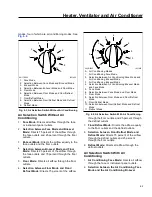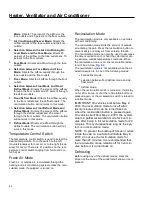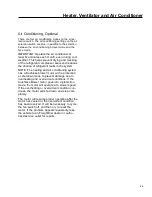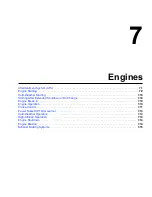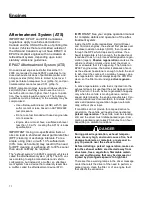
•
Use ultralow-sulfur diesel with 15 ppm sulfur
content or less.
•
Do not use fuel blended with used engine lube
oil or kerosene.
•
Engine lube oil must have a sulfated ash level
less than 1.0 wt %; currently referred to as
CJ-4 oil.
•
Adequate maintenance of the engine and the
diesel-particulate filter are the responsibility of
the owner/operator, and are essential to keep
the emission levels low. Good operating prac-
tices, regular maintenance, and correct adjust-
ments are factors that will help to stay within
the regulations.
The driver should be familiar with the vehicle warning
system in order to bring the vehicle to a safe stop if
the engine malfunctions. If the driver doesn’t under-
stand how the warning system works, an engine
shutdown could occur, causing a safety hazard. See
Chapter 3
for information.
All engines have an operating range specific to that
engine in which the engine performs most efficiently.
The operating range extends from maximum torque
rpm at the low end to engine rated speed at the high
end. Most engines deliver best fuel economy when
operated in the low- and mid-speed segments of the
efficiency range and produce maximum horsepower
at rated speed, which is also the recommended
maximum speed of the engine. For specifics for any
engine refer to the engine manufacturer’s operation
manual.
Prolonged idling of engines is not recommended, and
is illegal in some states. The belief that idling a die-
sel engine causes no engine damage is wrong. Idling
produces sulfuric acid, that is absorbed by the lubri-
cating oil, and eats into bearings, rings, valve stems,
and engine surfaces. If you must idle the engine for
cab heat or cooling, the high idle function of the
cruise control switches should be used. An idle
speed of 900 rpm should be enough to provide cab
heat in above freezing ambient temperatures.
If the engine is programmed with the idle shutdown
timer, ninety seconds before the preset shutdown
time, the CHECK ENGINE light will begin to flash at
a rapid rate. If the position of the clutch pedal or ser-
vice brake changes during this final ninety seconds
(CHECK ENGINE lamp flashing) the idle shutdown
timer will be disabled until reset.
Cruise Control
WARNING
Do not use the cruise control system when driv-
ing conditions do not permit maintaining a con-
stant speed, such as in heavy traffic or on roads
that are winding, icy, snow-covered, slippery, or
roads with a loose driving surface. Failure to fol-
low this precaution could cause a collision or
loss of vehicle control, possibly resulting in per-
sonal injury or property damage.
Dash-Mounted Switches
NOTICE
Do not attempt to shift gears without using the
clutch pedal when the cruise control is engaged.
Failure to follow this precaution will result in a
temporarily uncontrolled increase in engine
speed; transmission damage and gear stripping
could result.
On standard models, cruise control is activated by
two dash switches (
Fig. 7.15
).
•
The On/Off Switch—this two-position rocker
switch bears the legend SPD CNTL on the
lower half of the switch. When cruise control is
on, an amber light illuminates in the top part of
the switch.
•
The Set/Resume Switch—this three-position
paddle switch bears the legend RES/ACC
above the paddle and SET/CST below the
paddle.
1.
To cruise at a particular speed, do these steps:
1.1
Press the upper half of the On/Off (rocker)
switch on the instrument panel.
1.2
Hold the accelerator pedal down until the
speedometer reaches the desired speed.
1.3
Momentarily lower the paddle of the Set/
Resume switch to SET/CST.
2.
To disengage the cruise control, do these steps:
2.1
Press down the brake pedal (on automatic
or manual transmission)
or
Press down the clutch pedal (on manual
transmission only)
Engines
7.11

